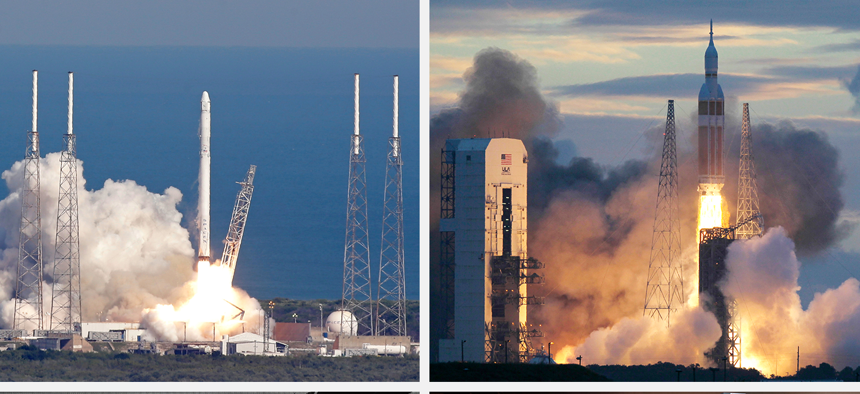
Clockwise from top left, SpaceX Falcon 9 rocket; a Delta IV rocket; scale model of Aerojet Rocketdyne's AR1 engine; and the Blue Origin rocket from Jeff Bezos. Photos by AP
It’s Time to Declare Our Independence from Russian Rockets
Attention, Congress: there are a range of alternatives to the RD-180, none of which run through Moscow.
Last week, the Pentagon sent a letter to Sen. Bill Nelson, D-Fla., an influential legislator when it comes to American space policy. Within the letter, Deputy Defense Secretary Robert Work, who is highly esteemed within the defense analytical community, stated that the Air Force lacked the flexibility to adopt a new rocket design based around a replacement for the controversial Russian RD-180 in the short term. Nor could the Air Force afford to use other rockets, presumably the Delta IV, as a replacement, given its fiscal constraint. He went on to say that unless the Congress authorized the additional purchase of RD-180 engines, the DoD’s space launch schedule could be pushed back up to two years, depriving the country of critical communications and presumably reconnaissance and surveillance capabilities. Ironically, the letter included a plaintive cry from the wilderness to save America’s rocket industry, presumably by purchasing Russian rocket engines.
To set the stage for this little drama, we must remember that following the end of the Cold War, it seemed appropriate to reach out to Russia and build partnerships to help bring their nation along economically and carve out paths that would bring them into the society of modern nations. Out of concern that Russia’s rocket technologies would proliferate, the U.S. government at President Bill Clinton’s direction urged its commercial defense companies to investigate purchasing Russian-built components to help keep the scientists of the Russian space agency together during the troublesome 1990s. As such, American rocket manufacturer Lockheed Martin incorporated the Russian RD-180 engine into the design of its Atlas V medium-heavy rocket, which saw its first launch in 2002.
However, Russia’s recent occupation of a portion of Georgia, its illegal annexation of Crimea and its operations of the Donbas region of Ukraine led to a series of sanctions against Russia and the temporary suspension of the sale of rocket engines to the United States. These activities revealed the United States’ vulnerability to Putin’s coercion, and triggered an initiative to regain U.S. independence from Russia with regard to space.
To be sure, the RD-180 engine itself is a marvel of engineering. Its dual combustion chamber, dual exhaust nozzle design generates 900,000 pounds of thrust, enough to lift 5- to 20-ton platforms into orbit. It is also reliable, having performed more than sixty commercial or military launches with only one operational burp that nonetheless reached orbit. The cost for an Atlas V launch is around $130 million, which is not too expensive when compared with previous military-grade rockets. The problem, as identified by the Congress, was the degree to which the United States is dependent upon an outside power, with which it has many disagreements, for access to space. The Senate Armed Services Committee, under the leadership of retired Navy Capt. John McCain, has introduced language requiring the U.S. military to abandon its strategic dependence on the Russian engine and use rockets powered by American thrust, and there are more than a few available.
Aerojet Rocketdyne, a tried and true builder of rockets going back to the earliest days of the Space Race, offers the AR-1 engine as a direct plug-and-play replacement for the RD-180 within the Atlas V rocket. However, the AR-1 is not fully tested and would not be available for a few years. Press reports suggest that both the Air Force and the United Launch Alliance seem to prefer billionaire Jeff Bezos’ Blue Origin BE-4 liquid methane-powered engine, which would be part of an entirely new Vulcan rocket with a 25-ton lifting capacity. The Vulcan rocket could be available by 2019 at a cost of $100 million per launch. Both of these options would require extending the United States window of vulnerability to Russian coercion until the early 2020s.
See also:
Before cutting off the RD-180, Congress should set the conditions for a better U.S. launch market
How the Delta IV engine could alter the U.S.-Russian calculus
A look at United Launch Alliance's "monopoly status in the national security launch market"
If Congress really wants to ditch Russia’s RD-180 engine, it needs to fund the research — and get ready to wait.
How 3-D printing could one day play a part
The nation does have other options, however. The Atlas V is not our only launching vehicle to space. The United Launch Alliance has the Delta IV rocket, capable of lifting five- to 30-ton platforms into orbit depending upon its configuration and has demonstrated the ability to launch multiple satellites per flight. The Delta IV is powerful, but also expensive, costing around $400 million per launch. Orbital ATK offers the Antares rocket, but it depends on Russian engines as well and does not answer the counter-coercion argument. Lastly, there is Elon Musk’s stunningly successful and innovative SpaceX effort.
Musk founded SpaceX in 2002 with funds garnered from his early investments in PayPal with the goal of lowering the costs associated with access to space and leading the way towards the manned exploration and colonization of Mars. His initial rocket, the Falcon 1, reached orbit in 2008, and the company has since moved onto its Falcon 9 rocket. SpaceX has pioneered the technologies necessary to land and reuse its booster stage and has recovered three of them on land and on a barge at sea. Such reuse promises dramatic mission cost decreases. As it stands, the Falcon 9, which can lift five to 25 tons into earth orbit, costs around $60 million.
SpaceX had to pursue legal proceedings against the Air Force to be allowed to bid for launch contracts, and the Air Force continues to meticulously and carefully review the reliability of the SpaceX design as a precursor for granting its authorization for using the rocket to launch national security payloads. The Falcon 9 has had 24 launches that resulted in 22 successful insertions into orbit. Of the two failures, one was a total mission loss due to a failed strut that breached a pressurized fuel cell during launch, and the second was a secondary payload failure that had no impact on the primary mission. Overall, the Falcon 9 system has demonstrated constant maturation and system reliability with the promise of dramatically lowered costs.
Dependence upon Russia for access to space is a bad strategic plan. As Senator McCain stated within last year’s NDAA, "The result will…deepen America’s reliance on these thugs for our military’s access to space.” At any point in time Russian instability and aggression could result in strains in the relationship that could sever access to Russian engines or even the Russian Soyuz launch vehicles that currently lift American astronauts to the International Space Station. We should remember that 20 percent of Georgia remains illegally occupied by Russia, Crimea remains illegally annexed by Russia, and 20,000 Russian troops remain as an occupying force on the ground in eastern Ukraine.
The world watches the United States, and we should not appease such aggression. Between SpaceX’s Falcon 9 and the United Launch Alliance’s Delta IV, which can be operated in a single-stick configuration, we have a range of options at varying costs that we can execute now, within this current budget cycle. We should not buy 18 engines as suggested by the House of Representatives. We should not buy nine engines as suggested by some in the Senate. With U.S. troops and its NATO allies conducting the largest deterrence exercise in a generation in Eastern Europe, it’s time to end our strategic schizophrenia, stop buying the RD-180 engine altogether, close our window of space vulnerability, and declare our independence in space again.
An earlier version of this story gave the wrong first name for Sen. Bill Nelson, D-Fla.




